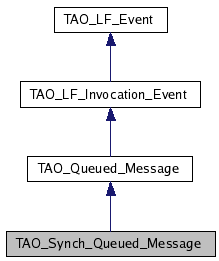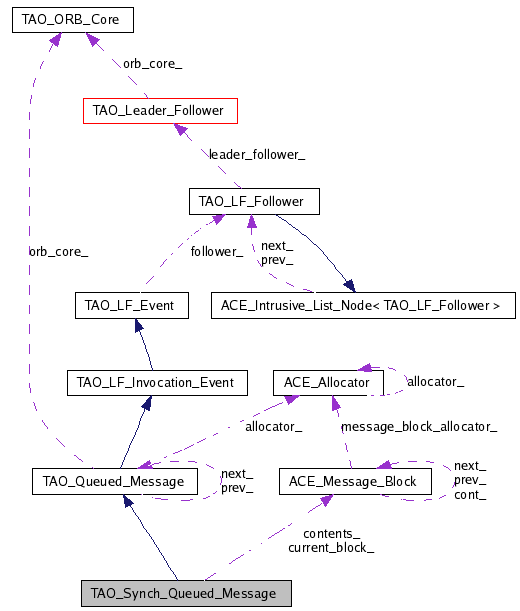
#include <Synch_Queued_Message.h>
Inheritance diagram for TAO_Synch_Queued_Message:


Public Member Functions | |
| TAO_Synch_Queued_Message (const ACE_Message_Block *contents, TAO_ORB_Core *oc, ACE_Allocator *alloc=0, bool is_heap_allocated=false) | |
| Constructor. | |
| virtual | ~TAO_Synch_Queued_Message (void) |
| Destructor. | |
| const ACE_Message_Block * | current_block (void) const |
Implement the Template Methods from TAO_Queued_Message | |
| virtual size_t | message_length (void) const |
| Return the length of the message. | |
| virtual int | all_data_sent (void) const |
| Return 1 if all the data has been sent. | |
| virtual void | fill_iov (int iovcnt_max, int &iovcnt, iovec iov[]) const |
| Fill up an io vector using the connects of the message. | |
| virtual void | bytes_transferred (size_t &byte_count) |
| Update the internal state, data has been sent. | |
| virtual TAO_Queued_Message * | clone (ACE_Allocator *alloc) |
| Clone this element. | |
| virtual void | destroy (void) |
| Reclaim resources. | |
Private Attributes | |
| ACE_Message_Block * | contents_ |
| The contents of the message. | |
| ACE_Message_Block * | current_block_ |
| The current message block. | |
Reliable requests block the sending thread until the message is sent, likewise, the sending thread must be informed if the connection is closed or the message times out.
In contrast oneway (and AMI) requests sent with the SYNC_NONE policy are simple discarded if the connection fails or they timeout.
Another important difference is the management of the data buffer: one SYNC_NONE messages the buffer is immediately copied into a newly allocated buffer, and must be deallocated. Other types of requests use the memory allocated by the sending thread.
| TAO_BEGIN_VERSIONED_NAMESPACE_DECL TAO_Synch_Queued_Message::TAO_Synch_Queued_Message | ( | const ACE_Message_Block * | contents, | |
| TAO_ORB_Core * | oc, | |||
| ACE_Allocator * | alloc = 0, |
|||
| bool | is_heap_allocated = false | |||
| ) |
Constructor.
| contents | The message block chain that must be sent. | |
| alloc | The allocator that is used to allocate objects of this type. |
| TAO_Synch_Queued_Message::~TAO_Synch_Queued_Message | ( | void | ) | [virtual] |
Destructor.
| int TAO_Synch_Queued_Message::all_data_sent | ( | void | ) | const [virtual] |
| void TAO_Synch_Queued_Message::bytes_transferred | ( | size_t & | byte_count | ) | [virtual] |
Update the internal state, data has been sent.
After the TAO_Transport class completes a successful (or partially successful) I/O operation it must update the state of all the messages queued. This callback method is used by each message to update its state and determine if all the data has been sent already.
| byte_count | The number of bytes succesfully sent. The TAO_Queued_Message should decrement this value by the number of bytes that must still be sent. |
Implements TAO_Queued_Message.
| TAO_Queued_Message * TAO_Synch_Queued_Message::clone | ( | ACE_Allocator * | alloc | ) | [virtual] |
| const ACE_Message_Block * TAO_Synch_Queued_Message::current_block | ( | void | ) | const |
| void TAO_Synch_Queued_Message::destroy | ( | void | ) | [virtual] |
Reclaim resources.
Reliable messages are allocated from the stack, thus they do not be deallocated. Asynchronous (SYNC_NONE) messages are allocated from the heap (or a pool), they need to be reclaimed explicitly.
Implements TAO_Queued_Message.
| void TAO_Synch_Queued_Message::fill_iov | ( | int | iovcnt_max, | |
| int & | iovcnt, | |||
| iovec | iov[] | |||
| ) | const [virtual] |
Fill up an io vector using the connects of the message.
Different versions of this class represent the message using either a single buffer, or a message block. This method allows a derived class to fill up the contents of an io vector, the TAO_Transport class uses this method to group as many messages as possible in an iovector before sending them to the OS I/O subsystem.
| iovcnt_max | The number of elements in iov | |
| iovcnt | The number of elements already used by iov, this method should update this counter | |
| iov | The io vector |
Implements TAO_Queued_Message.
| size_t TAO_Synch_Queued_Message::message_length | ( | void | ) | const [virtual] |
Return the length of the message.
If the message has been partially sent it returns the number of bytes that are still not sent.
Implements TAO_Queued_Message.
The contents of the message.
The message is normally generated by a TAO_OutputCDR stream. The application marshals the payload, possibly generating a chain of message block connected via the 'cont()' field.
The current message block.
The message may be set in multiple writev() operations. This point keeps track of the next message to send out.
 1.4.7-1
1.4.7-1